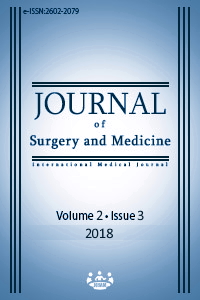Can failure of choledochal cannulation in endoscopic retrograde cholangiopancreatography be prevented?
Keywords:
Endoscopic retrograde cholangiopancreatography, Choledochal cannulation, PreventionAbstract
Aim: Endoscopic retrograde cholangiopancreatography (ERCP) is frequently used in the diagnosis and treatment of hepatic, biliary and pancreatic diseases. Failure during cannulation, however, requires other interventions. The purpose of this work is to create the parameters that can be used to predict failure during ERCP.
Methods: Case control study planned. ERCP procedures between December 2016 and February 2018 were evaluated. Duplicate attempts and causes, cannulation status were recorded and the factors affecting cannulation were examined. Descriptive analyzes were used for statistical evaluation, chi-square test for categorical data and t-test for continuous data. A p value of 0.05 or less was considered statistically significant in the analysis.
Results: A total of 458 ERCP procedures were performed in 288 patients during the study period. 159 of the patients were female, 129 were male, female / male ratio was 1.2, mean age was 59±17.9 and age range was 17-105. When ERCP indications were evaluated, 258 patients (89.6%) were treated due to choledocholithiasis. In the first procedure, selective choledochal cannulation was successful in 257 (89.3%) patients (229 patients with ERCP catheter and 28 patients with assisted methods), and these patients constituted study group. The remaining patients who cannulation was failed included in control group. There were no age and gender differences in the patients who failed cannulation (p: 0.270, 0.256, respectively). In failed cases, the duodenal diverticulum and pancreas head tumor were seen. In the first operation, 264 patients, mainly choledocholithiasis (n: 214), could be diagnosed.
Conclusion: It has been shown that the gender and age of the patient and structural differences such as the duodenal diverticulum do not affect the success of cannulation during ERCP. Upper abdominal operations like Billroth II and Roux-en-Y gastrojejunostomy reduce the success rate of cannulation. It is thought that the correlation between experience level of endoscopist and cannulation success.
Downloads
References
Cheng CL, Sherman S, Watkins JL, Barnett B, et al. Risk Factors for Post-ERCP Pancreatitis: A Prospective Multicenter Study. Am J Gastroenterol. 2006;101:139-47.
Freeman ML, DiSario JA, Nelson DB, Fennerty MB, et al. Risk factors for post-ERCP pancreatitis: a prospective, multicenter study. Gastrointest Endosc. 2001;54:425-34.
Fukatsu H, Kawamoto H, Kato H, et al. Evaluation of needleknife precut papillotomy after unsuccessful biliary cannulation, especially with regard to postoperative anatomic factors. Surgical Endoscopy and Other Interventional Techniques. 2008;22(3):717–23.
Perdue DG, Freeman ML. ERCOST Study Group. Failed biliary ERCP: a prospective multicenter study of risk factors, complications and resource utilization. Gastrointestinal Endoscopy. 2004;59(5):192.
Freeman ML. Adverse outcomes of endoscopic retrograde cholangiopancreatography. Rev Gastroenterol Dis. 2002;2:147-68.
Freeman ML. Adverse outcomes of ERCP. Gastrointest Endosc. 2002;56:273-82.
Sherman S, Lehman GA. Complications of endoscopic retrograde cholangiopancreatography and endoscopic sphincterotomy. In: Barkin J, O’Phelan CA, eds. Advanced Therapeutic Endoscopy New York: Raven Press 1990:201-10.
Masci E, Toti G, Mariani A, et al. Complications of diagnostic and therapeutic ERCP: a prospective multicenter study. Am J Gastroenterol. 2001;96:417-23.
Freeman ML, Nelson DB, Sherman S, et al. Complications of endoscopic biliary sphincterotomy. N Engl J Med. 1996;335:909-18.
Freeman ML, Nelson DB, Sherman S, et al. Same-day discharge after endoscopic biliary sphincterotomy: observations from a prospective multicenter complications study. Gastrointest Endosc. 1999;49:580-6.
Leung JWC, Chan FKL, Sung JJY, Chung S. Endoscopic sphincterotomy- induced hemorrhage: a study of risk factors and the role of epinephrine injection. Gastrointest Endosc. 1995;42:550-4.
Lobo DN, Balfour TW, Iftikhar SY. Periampullary diverticula: consequences of failed ERCP. Annals of the Royal College of Surgeons of England. 1998;80(5):326–31.
Boix J, Lorenzo-Z´u˜niga V, A˜na˜nos F, Dom`enech E, Morillas RM, Gassull MA. Impact of periampullary duodenal diverticula at endoscopic retrograde cholangiopancreatography: a proposed classification of periampullary duodenal diverticula. Surgical Laparoscopy, Endoscopy and Percutaneous Techniques. 2006;16(4).208–11.
Choudari CP, Sherman S, Fogel EL, et al. Success of ERCP at a referral center after a previously unsuccessful attempt. Gastrointestinal Endoscopy. 2000;52(4):478–83.
Baron TH, Petersen BT, Mergener K, et al. Quality indicators for endoscopic retrograde cholangiopancreatography. American Journal of Gastroenterology. 2006;101(4): 892–97.
Downloads
- 1376 1846
Published
Issue
Section
How to Cite
License
Copyright (c) 2018 Yahya Kemal Çalışkan, Mustafa Uygar Kalaycı
This work is licensed under a Creative Commons Attribution-NonCommercial-NoDerivatives 4.0 International License.















